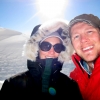CHAPTER 6
Here at the Pole, we have become used to sunlight. It shines here all the time- 24/7. Because it is the middle of summer, the sun makes a continual circuit around the sky, reaching a maximum height above the horizon of 23.5° (the tilt of the axis of the earth) on the summer solstice, December 22nd. Around and around it goes, making every hour of every day pretty much the same, as far as the scene outside is concerned. The only difference during the day, baring bad weather or clouds, is that the sun is on the right side of the station when we walk to work, and it is on the left side when we leave. In fact, every shadow here acts like a perfect sundial- but you don’t even need a shadow, you can tell exactly what time of day it is by simply observing which direction the sun is.
What’s more, the sun also acts like a compass- Colorado is 4 hours ahead (though a day behind) of us here at the Pole, so when my watch shows 8am, that means it is 12 noon there, with the sun overhead in Denver. From my perspective on the ice, at 8am, the sun is a needle pointing directly in the direction of Denver. Now there are obviously some technicalities with daylight savings time and Denver’s location within the Mountain time zone, but you get the point.
Aside from these trivial solar oddities, the sun doesn’t do much to draw attention to itself on a regular basis, but the other day something spectacular occurred- a solar eclipse. Solar eclipses happen when the moon passes between us and the sun and casts a shadow on the face of the Earth. You would think this would occur every time the moon went around, but it turns out that the moon’s orbit is slightly tilted a couple of degrees, and therefore most of the time, the shadow it casts passes either below or above the earth in space. On this occasion, the moon and sun were not quite lined up exactly, which lead to only a partial eclipse with about 77% of the sun being covered. That being said, it was still pretty special because here at the South Pole, we were one of the few places on earth that got to witness it.
It took about two hours from start to finish, so there was plenty of time for everyone to gather in the galley and set up shadow boxes or use welding goggles to view the phenomenon. It was a little crowded for my liking, so I decided to go outside for a better view. Using my tripod and a piece of Mylar (a thin metal material similar to a potato chip bag) that a scientist gave me, I covered my camera lens to filter out most of the sun’s light which allowed me to look directly at it. It took a little messing around with the camera settings, but I ended up with some cool photos before I got too cold and had to run back inside. Not only can you see the eclipse clearly, you can also make out dark dots on the face of the sun which are actually sun spots- huge areas bigger than the earth that are relatively cooler than the surrounding areas. From these sunspots occasionally come enormous explosions of energy and particles, called coronal mass ejections, which if directed at the earth can cause trouble with satellites up in space and even disrupt our power grids down here on earth, sometimes with catastrophic consequences.
Prev ChapterNext Chapter

